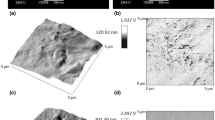Abstract
It is shown that the parameter of the adhesion process—the maximum number of fungal spores adhering to polymeric materials—makes it possible to assess the ability of the Aspergillus niger (A. niger) fungus and varnished cambric to adhesive interaction in various temperature and humidity conditions. The value of this parameter is determined mainly by humidity and practically does not depend on the ambient temperature. An analytical dependence of the maximum adhesion number on air humidity is obtained. The research results can be used to develop methods for assessing and forecasting the contamination of materials by microorganisms-destructors in various climatic conditions.


Similar content being viewed by others
REFERENCES
S. A. Semenov, K. Z. Gumargalieva, and G. E. Zaikov, Vestn. MITKhT 3 (2), 3 (2008).
K. Z. Gumargalieva, S. A. Sevenov, I. G. Kalinina, et al., Rubber, Fibre, Plastic, Int. 6 (2), 114 (2011).
I. G. Kalinina, K. Z. Gumargalieva, V. V. Kazarin, and S. A. Semenov, Russ. J. Phys. Chem. B 11, 304 (2017).
I. G. Kalinina, S. A. Semenov, K. Z. Gumargalieva, and V. V. Kazarin, Russ. J. Phys. Chem. B 12, 155 (2018).
GOST (State Standard) No. 9.048-89 USPCA, Technical products. Laboratory test methods for resistance to mold fungi (1994).
GOST (State Standard) No. 9.049-91 USPCA, Polymeric materials and their components. Laboratory test methods for resistance to mold fungi (1994).
H. Schlegel, General Microbiology (Cambridge Univ. Press, Cambridge, 1993).
G. B. Calleja, in Microbial Adhesion and Aggregation, Ed. by K. C. Marshall (Springer, Berlin, 1984), p. 303.
I. G. Kalinina, K. Z. Gumargalieva, S. A. Semenov, V. V. Kazarin, and O. A. Zhdanova, Russ. J. Phys. Chem. B 13, 345 (2019).
B.-E. Priegnitz, A. Wargenau, U. Brandt, et al., Fungal Genet. Biol. 49, 30 (2012).
B. J. Reginald Thio and J. Carson Meredith, Colloids Surf., B 65, 308 (2008).
K. Kendall, Molecular Adhesion and its Applications (Kluwer Acad., Boston, 2004).
A. D. Zimon, Adhesion of Dust and Powder (Khimiya, Moscow, 1967; Springer, New York, 1982).
I. S. Zvyagintseva and D. G. Zvyagintsev, Biol. Nauka, No. 5, 20 (1998).
Jianyu Zhu, Qian Li, Weifeng Jiao, et al., Colloids Surf., B 94, 95 (2012).
H. N. Kim and Sh. L. Walker, Colloids Surf., B 71, 160 (2009).
Funding
The study was financed as part of state assignment no. GZ-0082-2019-0008 (AAAA-A20-120030590042-8) of the Semenev Federal Research Center for Chemical Physics, Russian Academy of Sciences and in accordance with state assignment no. 0082-18-006 (state registration number AAAA-A18-118020890097-1).
Author information
Authors and Affiliations
Corresponding author
Rights and permissions
About this article
Cite this article
Kalinina, I.G., Ivanov, V.B., Semenov, S.A. et al. Influence of the Temperature And Humidity Conditions on the Adhesive Interaction of Spores of the Aspergillus niger Fungus with Varnished Cambric. Russ. J. Phys. Chem. B 15, 506–509 (2021). https://doi.org/10.1134/S1990793121030210
Received:
Revised:
Accepted:
Published:
Issue Date:
DOI: https://doi.org/10.1134/S1990793121030210




